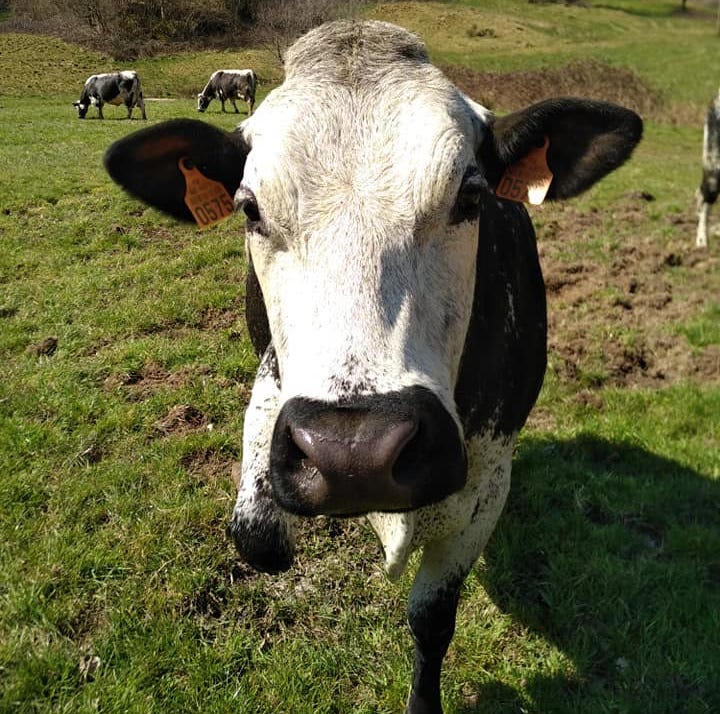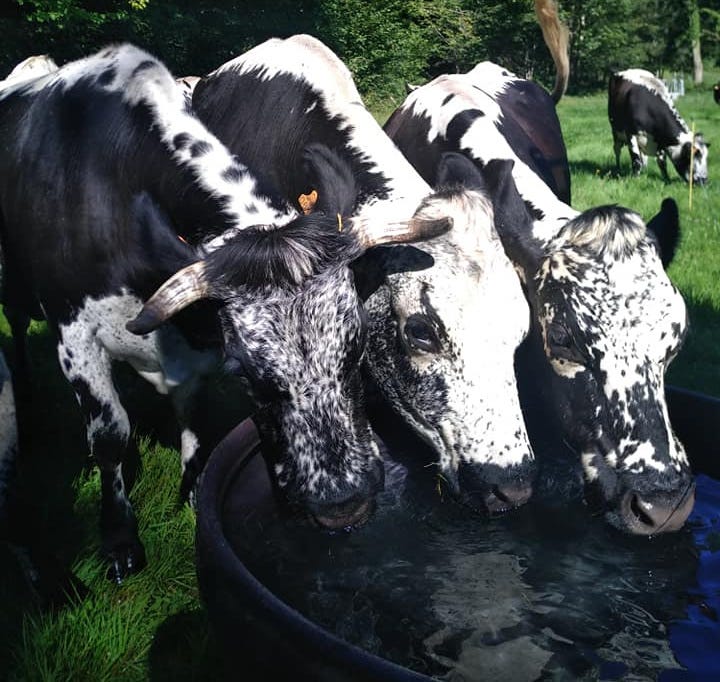
One of the Vaxelaire herd
By Sam Harrison
When the pandemic hit France in March, dairy farmers Laura and Lionel Vaxelaire saw orders for the Munster, tomme, and yogurt their small farm in the Vosges produces plummet.
The Vaxelaire tomme, a “fromage de garde,” is meant for months of storage (traditionally, to be saved for winter), so the cheesemakers knew it would keep. But Munster, made from unpasteurized cow’s milk, is designed to be eaten fresh. Any new batches the Vaxelaires made risked spoiling before they could sell it.
For a cheese to become Munster, it needs to ripen in the cellar for 21 days. During that period, it’s cleaned with a humid cloth three times a day, and turned over several times a week to develop its signature orange crust.
Rather than risk rotten cheese, the couple decided to experiment: they left a batch of base cheese in their cellar without cleaning or turning it, and let it ripen and form its crust naturally.
“It was the chance to see what could happen. Why not try something new?” said Laura.
Left to mature on its own, the cheese developed a speckled, white and grey bloomy rind and a mild flavor. When their kids tried it and immediately asked for seconds, they knew they had a hit.

More of the Vaxelaire herd
They christened their creation Le Confiné, the confined, named for the COVID-19 lockdown.
“The name came naturally, since it was created during confinement,” said Laura. “In a way, it was confined too, in our cheese ripening cellar.”
Experimenting with new cheeses this way is rare. Successful cheesemakers have orders to fill, and few reasons to change a proven formula. “It requires more capital and time,” explains Jeanette Hurt, food writer and author of several books on cheese, including “The Complete Idiot's Guide to Cheeses of the World.”
Customers loved Le Confiné, and the Vaxelaires have continued making it, even as French lockdown restrictions have loosened. But since they only sell their cheeses at their farm, Au Petit Gravier, and local markets, anyone interested in tasting lockdown cheese will have to travel to the Vosges—once it’s safe to do so. 🐄

Chili Crisp Is Taking Over the World
I first found out about chili oil while studying Mandarin in Guilin, China in 2002. My professor made sure to familiarize us with traditional Chinese food, and our noodles, dumplings, soups, and sautéed vegetables were always served alongside a container of rich and spicy chili oil.
Fast forward 18 years and my appreciation for chili oil has turned into a full-blown obsession with “chili crisp,” chili oil’s textured and even more addictive cousin: chili crisp is studded with fermented soy beans and fried garlic that provide crunch and impart a deeper umami flavor.
When the pandemic hit, I was unable to purchase my favorite brand of chili crisp, Lao Gan Ma, at New York’s quickly and completely shuttered Chinatowns, so I was grateful to find a 24-ounce bottle online to top my dumplings, peanut noodles, pizzas, Indian curries, and tempeh meatballs. I know I’m not alone in my obsession, as 3,500 worldwide enthusiasts join me in The Lao Gan Ma Appreciation Society on Facebook, where we share recipes and food porn pics like Greek yogurt topped with charred cherry tomatoes that were roasted in Lao Gan Ma chili oil and lemon rind.
Lao Gan Ma has exploded in popularity and was discussed in a recent podcast by celebrity chefs Eddie Huang and Dave Chang. What can we attribute to the rising popularity of the self-proclaimed “Best Chinese Chili Sauce” that has a makeshift website and only 42 Twitter followers?
According to Mama Ji, the Chengdu-born and Beijing-raised mother of one of my best friends, Lao Gan Ma’s addictiveness can be attributed to trace amounts of opium. Despite her conspiracy theory (one that is not uncommon in China), she continues to pour it over her noodles while simultaneously ordering her daughter to moderate her own intake “so her face won’t get zits.” I’ll note that I found no substantiated link between Lao Gan Ma – or any brand of chili crisp – and adult acne, or any credible evidence of the presence of opium.

One of the many pieces of unauthorized Lao Gan Ma swag on the internet
The cultural anthropologist, ecologist, and self-described “chili cultist” Gerald Zhang-Schmidt has a much simpler answer. Zhang-Schmidt has been growing and researching chilis and their cultural-culinary importance for 25 years and believes Lao Gan Ma simply benefitted from entering the chili crisp game early, expanding well internationally, and having a name that’s easy enough for non-Chinese speakers to pronounce. He adds that it may be symbolic of Lao Gan Ma’s iconic status how “many people speak simply of ‘Lao Gan Ma’ as if it were one type of product, a chili crisp, when Lao Gan Ma is really the company name with a pretty diverse product line.”
Lao Gan Ma has yet to diversify beyond chili oils and pastes but its fans are going nuts over a Lao Gan Ma-flavored vanilla ice cream produced by an ice cream shop in Alameda, California. Here in New York City, some are discussing crowdfunding a shipment to get their fix. Until then, we’re grateful that Chinatowns have reopened in Brooklyn, Manhattan, and Queens, and there’s plenty of chili crisp for sale. 🌶
If you’re enjoying Smart Mouth, please consider signing up for a paid subscription. The money goes toward paying our contributors. Substack sets the minimum at $5/month, so you can't give less than that,* but please feel absolutely free to give more.
*If you would like to give less than $5, you can do that via Patreon, and it is very helpful and appreciated! You will also get podcast episodes one week early!

New episode! Penang Curry with Caleb Hearon
A curry for the people!
Say, as an omnivore, what meat WON’T you eat, and why?
You can listen to Smart Mouth on iTunes, on Stitcher, on Spotify - or any other podcast player!
More Food Reading:
This feature on automated farming leaves no stone unturned - Twilight Greenaway considers every possible angle.
Jeanelle Hayner Olson has a delightful essay about why, and how much, she loves White Russians.
We’re all happy the Great British Baking Show is back, and we should all be reading Allison Robicelli’s recaps. Bathe in the joy of discussing quirky Brits!
This newsletter is edited by Katherine Spiers, host of the podcast Smart Mouth.
A TableCakes Production.
Want to contribute? Here are the submission guidelines.



